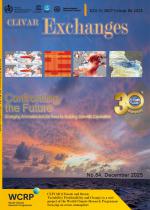Extremes Cross-Cut
In recent years, the occurrence of extreme events as well as the associated damage has increased. Key activities under WCRP's cross-cutting activity on extremes are pushed forward by WCRP's Drought Interest Group (DIG). Further information can be found on the DIG webpages. Information on WCRP's other cross-cuts can be found on the website under 'Key Deliverables": http://www.wcrp-climate.org/
Other WCRP research on extreme events includes cold periods (CliC), the intensity of monsoons (MAIRS), and the probability of occurrence of short time scale extreme events dependent on mean climate characteristics: tropical cyclones, mid- and high-latitude storms, severe frosts (CliC), air pollution extremes (SPARC) and heavy precipitation. WCRP is developing new projects jointly with THORPEX focussing on the predictability of atmospheric extremes. The CLIVAR Working Group on Seasonal to Interannual Preidiction (WGSIP) oversees development of improved models, assimilation systems and observing system requirements for seasonal prediction. WCRP works closely with the WMO Disaster Prevention and Mitigation Programme to deliver improved forecasting skill to those affected by climate extremes.
The WCRP Working Group on Coupled Modelling is addressing global climate change and the frequency and intensity of extreme events, and how to forecast extremes in a changing climate as part of climate scenarios for the 21st Century. The joint CCl/CLIVAR/JCOMM Expert Team (ET) on Climate Change Detection and Indices (ETCCDI) organized the development of user-friendly analysis software, organized 5 capacity building workshops contributing to a global extremes indices paper as well as other peer reviewed papers which contributed to IPCC AR4. WCRP contributes to research on atmospheric and marine chemical extreme events (e.g. coral reef bleaching) and risk (e.g. tropospheric air pollution or high surface UV radiation) in collaboration with the International Geosphere-Biosphere Programme (IGBP) and the Intergovernmental Oceanographic Commission (IOC).
Whilst the Third IPCC Assessment (2001) made some statements about both (i) observed changes in extremes and (ii) projected changes in extremes, now, in 2007, the Fourth Assessment Report of the IPCC contains quite strong statements regarding already observed and expected changes in climate extremes, the latter based on analyses of the outputs of the WCRP AR4 model archive. As a result of this assessment process it has, however, become very clear that there is no adequate definition of what constitutes a climate extreme and, worse, there is no overarching framework under which either observations or projections of such climate extremes can be assessed.










